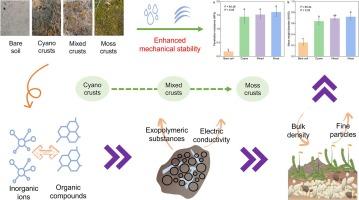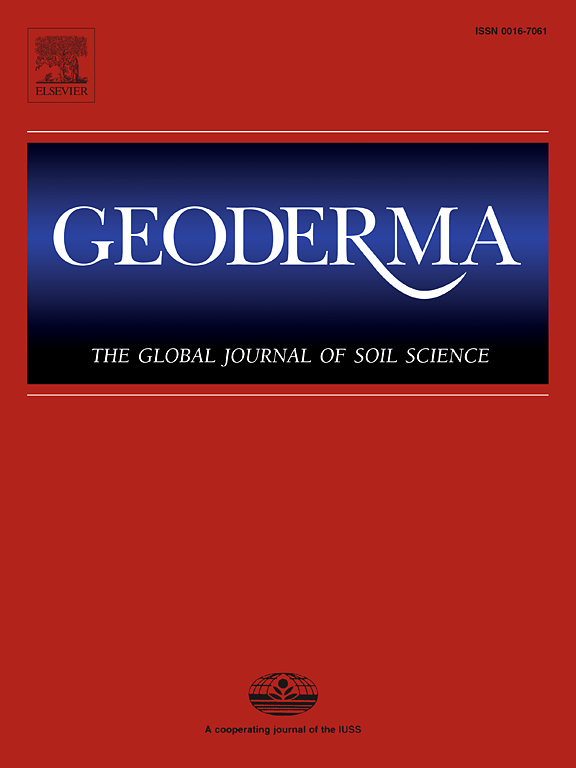研究旱地生物簇的机械稳定性:无机离子和有机化合物及其相互作用的启示
IF 5.6
1区 农林科学
Q1 SOIL SCIENCE
引用次数: 0
摘要
生物簇是旱地生态系统的重要组成部分,因为它们具有稳定土壤、调节水文循环和改善养分供应等重要生态功能。据了解,生物簇的高机械稳定性与外聚合物质(EPS)有关,而EPS又负责吸附各种离子和化合物。本研究旨在调查生物簇的化学成分,并评估其化学成分与机械稳定性之间的潜在关联。研究人员从中国黄土高原北部采集了三种类型的生物结壳(蓝藻、蓝藻与苔藓混合结壳、苔藓结壳)和裸土(作为对照)。采用电感耦合等离子体光发射光谱法、离子色谱法和气相色谱-质谱法对生物菌壳中的无机离子和有机化合物进行了定量分析。通过渗透阻力(PR)和聚集体的平均重量直径(MWD)评估了生物簇的机械稳定性。最后,还阐明了无机离子和有机化合物对生物簇稳定性的影响。结果表明,所有三种类型的生物结壳都比裸土更稳定,其中苔藓结壳最为稳定。化学分析显示,生物簇中富含 K+、Ca2+、Na+、Mg2+、SO42- 和卤素离子等无机离子,而缺少 Fe2+、Al3+ 和 NO3-。在生物簇和裸露土壤中发现了 10 种有机化合物,其中以中链烷烃和长链酸为主。在某些情况下,酸类占生物簇有机化合物总含量的 40% 以上。冗余分析表明,无机离子(如 Ca2+ 和 Mg2+)和有机化合物(如酸、酰胺和烯)的含量与生物簇稳定性的关系最为密切。偏最小二乘法路径模型表明,无机离子和有机化合物通过影响电导率、体积密度、EPS 和细颗粒(粘土和淤泥)含量间接影响生物簇稳定性。无机离子与 PR 和 MWD 之间存在密切联系(分别为 0.658 和 0.744),而有机化合物对 PR 和 MWD 的总影响分别为 0.814 和 0.801。这表明,与 EPS 相关的化学物质的数量和类型都表明它们有能力赋予生物簇机械稳定性,这反过来又有利于维持全球旱地生物簇的关键功能。本文章由计算机程序翻译,如有差异,请以英文原文为准。

Towards the mechanical stability of biocrusts in drylands: Insights from inorganic ions and organic compounds and their interactions
Biocrusts are an important component of dryland ecosystems as they perform crucial ecological functions like stabilizing soils, mediating the hydrological cycle, and improving nutrient availability. The high mechanical stability of biocrusts is understood to be linked to exopolymeric substances (EPS), which in turn, are responsible for the adsorption of various ions and chemical compounds. This study aimed to investigate the chemical composition of biocrusts and assess potential correlations between their chemical composition and mechanical stability. Samples of three types of biocrusts (cyanobacteria, cyanobacteria and moss mixed, and moss crusts) and bare soil (as control) were collected from the northern Loess Plateau of China. The inorganic ions and organic compounds present in biocrusts were quantified using inductively coupled plasma-optic emission spectrometry, ion chromatography, and gas chromatography-mass spectrometry. Biocrust mechanical stability was assessed by penetration resistance (PR) and the mean weight diameter (MWD) of aggregates. Finally, the contribution of inorganic ions and organic compounds to the stability of the biocrusts was elucidated. The results indicated that all three types of biocrusts were more stable than bare soil, with moss crusts being the most stable. Chemical analyses revealed an enrichment of inorganic ions such as K+, Ca2+, Na+, Mg2+, SO42–, and halogen ions within the biocrusts, while they showed a depletion of Fe2+, Al3+, and NO3–. Ten types of organic compounds were identified in biocrusts and bare soil, with medium-chain alkanes and long-chain acids being the dominant compounds. In some cases, acids accounted for more than 40 % of the total organic compound content of the biocrusts. Redundancy analysis showed that the content of inorganic ions, such as Ca2+ and Mg2+, and organic compounds such as acids, amides, and alkenes, exhibited the closest association with the biocrust stability. Partial least squares path modeling indicated that both inorganic ions and organic compounds indirectly affected biocrust stability by influencing electric conductivity, bulk density, EPS, and fine particle (clay and silt) content. A strong association was found between the inorganic ions and both PR and MWD (0.658 and 0.744, respectively), whilst the total effects of organic compounds on PR and MWD were 0.814 and 0.801, respectively. It is suggested that both the magnitude and types of chemicals associated with EPS indicate their capability to grant mechanical stability of the biocrusts, which in turn is conducive to maintaining the critical functions of biocrusts in global drylands.
求助全文
通过发布文献求助,成功后即可免费获取论文全文。
去求助
来源期刊

Geoderma
农林科学-土壤科学
CiteScore
11.80
自引率
6.60%
发文量
597
审稿时长
58 days
期刊介绍:
Geoderma - the global journal of soil science - welcomes authors, readers and soil research from all parts of the world, encourages worldwide soil studies, and embraces all aspects of soil science and its associated pedagogy. The journal particularly welcomes interdisciplinary work focusing on dynamic soil processes and functions across space and time.
 求助内容:
求助内容: 应助结果提醒方式:
应助结果提醒方式:


